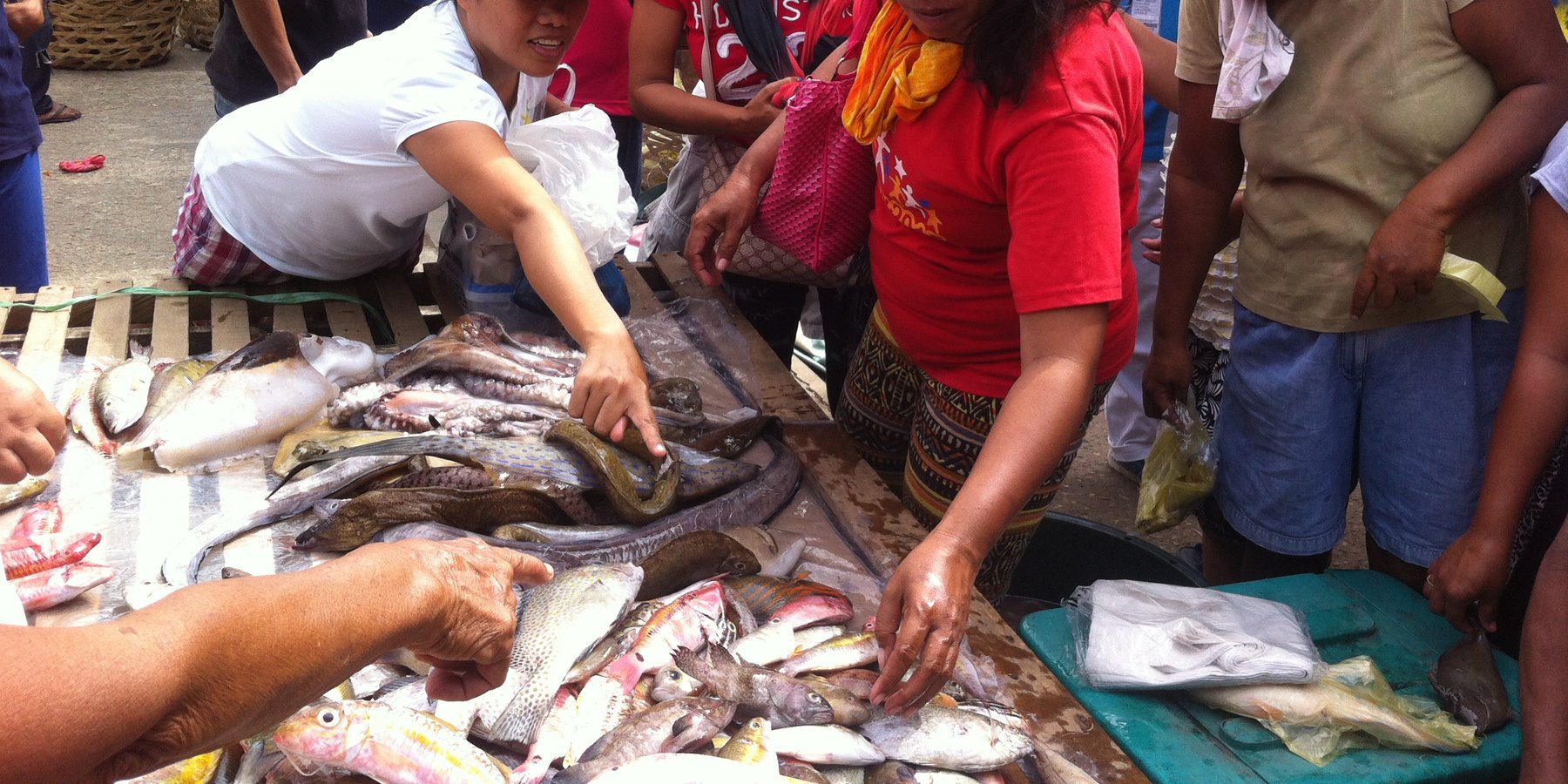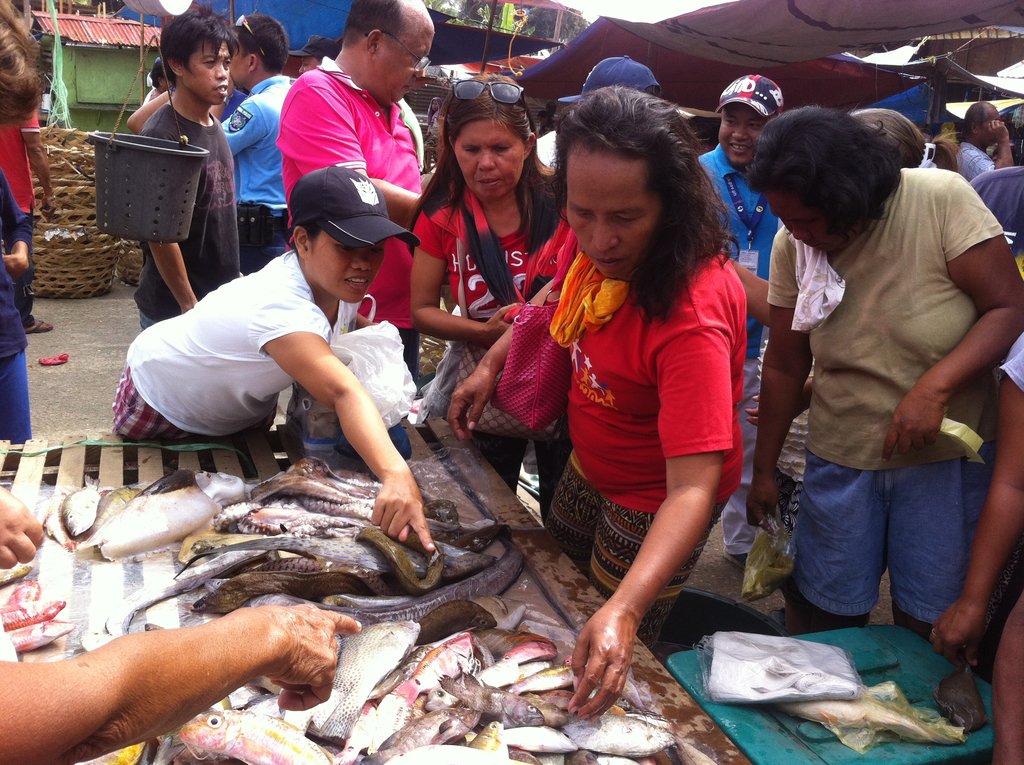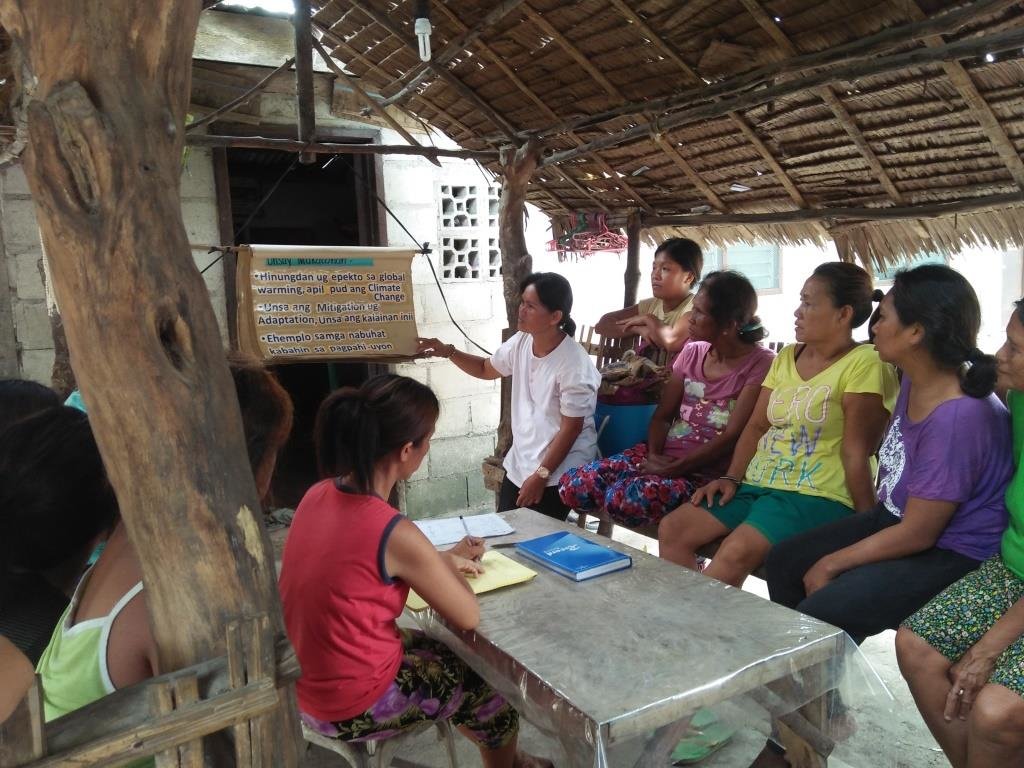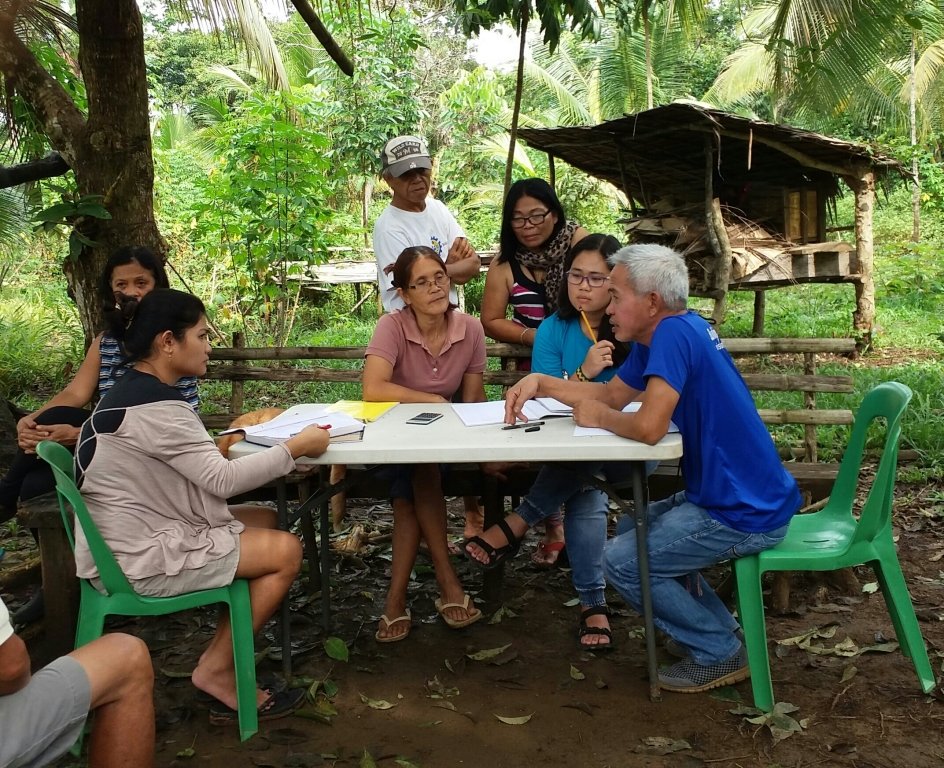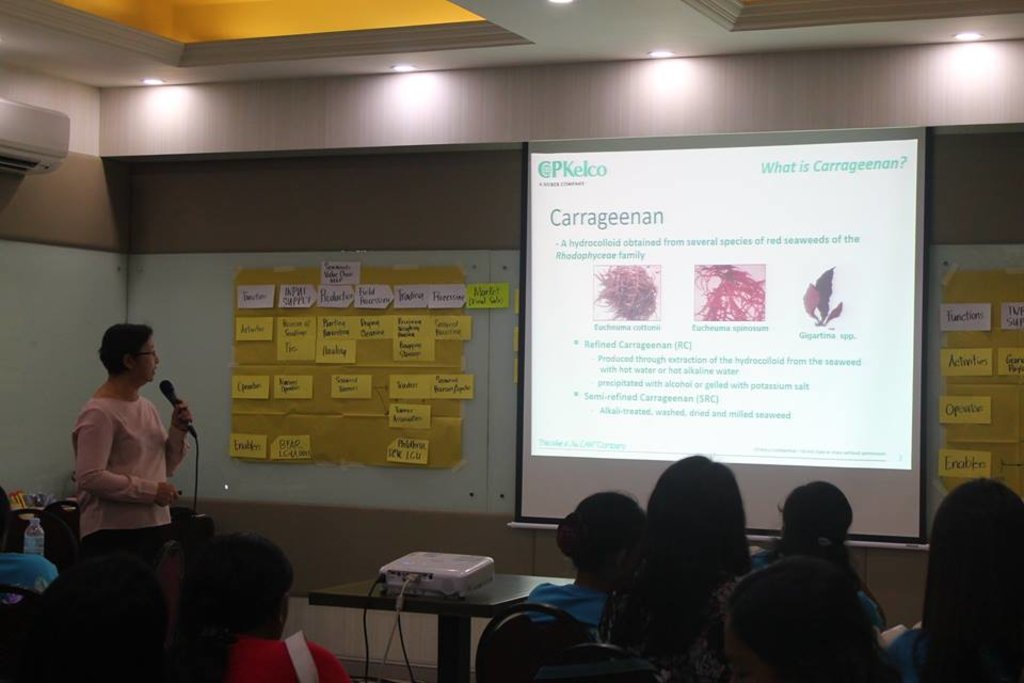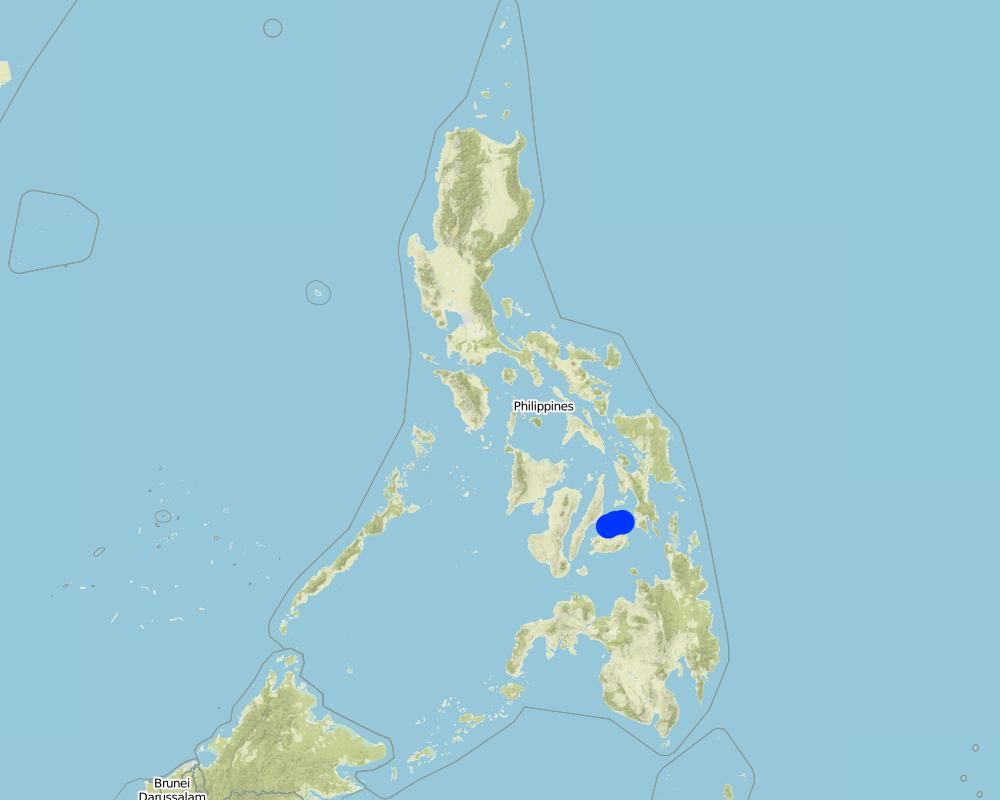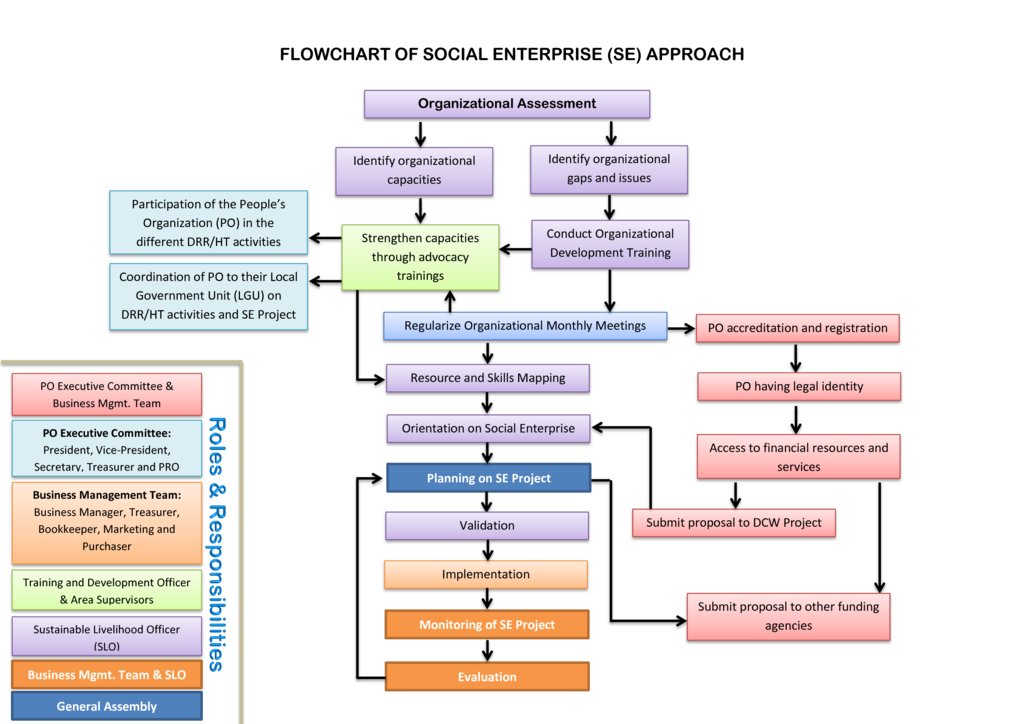Social Enterprise (SE) [ຟີລິປິນ]
- ການສ້າງ:
- ປັບປູງ:
- ຜູ້ສັງລວມຂໍ້ມູນ: Keeshia Lynn Marie Austria
- ບັນນາທິການ: –
- ຜູ້ທົບທວນຄືນ: Alexandra Gavilano
Katilingbanong Patigayon
approaches_3119 - ຟີລິປິນ
ເບິ່ງພາກສ່ວນ
ຂະຫຍາຍທັງໝົດ ຍຸບທັງໝົດ1. ຂໍ້ມູນທົ່ວໄປ
1.2 ລາຍລະອຽດ ການຕິດຕໍ່ ຂອງບຸກຄົນທີ່ຊັບພະຍາກອນ ແລະ ສະຖາບັນ ການມີສ່ວນຮ່ວມ ໃນການປະເມີນຜົນ ແລະ ເອກະສານ ຂອງວິທີທາງ
ບຸກຄົນສຳຄັນ (ຫຼາຍຄົນ)
Sustainable Livelihood Officer (SLO):
ຟີລິປິນ
ຊື່ຂອງໂຄງການ ທີ່ອໍານວຍຄວາມສະດວກ ໃນການສ້າງເອກກະສານ ຫຼື ປະເມີນດ້ານແນວທາງ (ຖ້າກ່ຽວຂ້ອງ)
Danajon Communities WATCH ( DCW)ຊື່ຂອງ ສະຖາບັນການຈັດຕັ້ງ ທີ່ອໍານວຍຄວາມສະດວກ ໃນການສ້າງເອກກະສານ ຫຼື ປະເມີນແນວທາງ (ຖ້າກ່ຽວຂ້ອງ)
Philippine Partnership for the Development of Human Resoruces in Rural Areasy (PhilDHRRA) - ຟີລິປິນ1.3 ເງື່ອນໄຂ ຂອງການນໍາໃຊ້ເອກກະສານຂໍ້ມູນ ຂອງ WOCAT
ເມື່ອໃດທີ່ໄດ້ສັງລວມຂໍ້ມູນ (ຢູ່ພາກສະໜາມ)?
04/04/2017
ຜູ້ສັງລວມ ແລະ ບັນດາຜູ້ຕອບແບບສອບຖາມ ຍອມຮັບໃນເງື່ອນໄຂ ການນໍາໃຊ້ຂໍ້ມູນເອກະສານ ທີ່ສ້າງຂື້ນ ໂດຍຜ່ານ ອົງການ WOCAT:
ແມ່ນ
1.4 ເອກະສານອ້າງອີງ (ຫຼາຍ) ກັບແບບສອບຖາມ (ຫຼາຍ) ເຕັກໂນໂລຢີ ຂອງດ້ານການຄຸ້ມຄອງ ດິນແບບຍືນຍົງ
2. ພັນລະນາ ແນວທາງການຄຸ້ມຄອງນໍາໃຊ້ດິນແບບຍືນຍົງ
2.1 ການອະທິບາຍ ໂດຍຫຍໍ້ ຂອງວິທີທາງ
Social Enterprise (SE) aimed to provide social protection among its members and generate additional family income. Above all, this approach will encourage the conservation, preservation and protection of the resources available in the community.
2.2 ການອະທິບາຍ ລາຍລະອຽດ ຂອງວິທີທາງ
ການອະທິບາຍ ລາຍລະອຽດ ຂອງວິທີທາງ:
Social Enterprise (SE) materialized because of the experiential processes conducted by the Sustainable Livelihood Officer. According to him, livelihood intervention should achieve the advocacy of the project, at the same time, relevant and suitable to the people living in the island and coastal communities. SE Approach was a result of the focus group discussions conducted in the community and livelihood consultations of the different stakeholders in the barangay level. According to the Local Government Code of the Philippines, Book III, Section 386 (a), A Barangay maybe created out of a contiguous territory which has a population of at least two thousand (2,000) inhabitants as certified by the National Statistics Office. Furthermore, Section 386 states that barangay is the basic political unit. It serves as the primary planning and implementing unit of government policies, plans, programs, projects, and
activities in the community, and as a forum wherein the collective views of the people may be expressed, crystallized and considered, and where disputes may be amicably settled.
Social Enterprise Project was determined using the following methods: resource mapping, identification of social enterprise project, planning and preparation which includes community equity fund, implementation, maintenance and monitoring, lastly, expansion and/or diversification of the implemented project. Once the enterprise is established, the organization will elect the members of their business management team. This is different from the set of officers typically present in every organization because business management team will focus on the business engagements only. The business management team is headed by the business manger, who will report directly to the president of the organization. The members of the team includes the following: treasurer, bookkeeper, purchaser and marketing team (if needed by the enterprise project).
The management team will receive 20% of the net income. Afterwards, the remaining net income will be divided according to the following percentage: 10% for disaster fund allocation, 10-20% for additional capital, and the remaining amount is allocated for individual member share. SE does not only focus on net profit but also the welfare of the community, its resources and social protection among its members. Social protection specifically means having disaster fund allocation per organization which is derived from the net income of the enterprise. This fund can be utilized by the organization before or after the onset of a disaster, depending on their agreed utilization guidelines. The sustainability components are the following: allocation for additional capital, depreciation cost for every equipment and experiential mentoring of the Livelihood Officer.
Based from the baseline study of DCW Project, Human Trafficking cases increased after a disaster. DCW project aimed to build resilient communities in order to combat Human Trafficking, however, conducting awareness sessions, coordination meetings with the local government unit and establishing HT referral system is not enough to prevent Human Trafficking. On the second year of the project, the project management team realized that livelihood component is the missing link in fighting against Human Trafficking. The body agreed that sustainable livelihood project means being adaptable and resilient to climate change. For the livelihood officer, group enterprise is an important mechanism in promoting adaptable and resilient livelihood project. This approach was granted to the People's Organization (PO) in the barangays who were organized or adopted by DCW project.
Due to the awareness sessions conducted, the organizations were motivated to join the advocacy activities like coastal clean-up and mangrove planting. They were also invited to join forums on the Solid Waste Management (SWM), referral pathway on Human Trafficking (HT) and awareness training on the causes and effects of Climate Change and sea level rise, since they are living in the island and coastal barangays. PO organizations serve as community partners of DCW project in facilitating learning sessions in the different barangays. Furthermore, DCW project provided inputs how to make their enterprise resilient and sustainable by being adaptive to the changing weather especially those organizations living in the island barangays.
2.3 ຮູບພາບຂອງແນວທາງ
2.5 ປະເທດ / ເຂດ / ສະຖານທີ່ບ່ອນທີ່ແນວທາງໄດ້ຖືກນໍາໃຊ້
ປະເທດ:
ຟີລິປິນ
ພາກພື້ນ / ລັດ / ແຂວງ:
Province of Bohol
Map
×2.6 ວັນທີເລີ່ມຕົ້ນ ແລະ ສິ້ນສຸດ ການຈັດຕັ້ງປະຕີບັດ ວິທີທາງ
ສະແດງປີຂອງການເລີ່ມຕົ້ນ:
2016
ຖ້າຫາກບໍ່ຮູ້ຈັກປີທີ່ແນ່ນອນ, ໃຫ້ປະມານຄາດຄະເນ ເອົາມື້ທີ່ໄດ້ເລີ່ມຈັດຕັ້ງປະຕິບັດ ວິທີທາງ:
ຕໍ່າກວ່າ 10 ປີ ຜ່ານມາ (ມາເຖິງປະຈຸບັນ)
ຄວາມຄິດເຫັນ:
The Social Enterprise project of the different organizations are currently ongoing.
2.7 ປະເພດຂອງແນວທາງ
- ພາຍໃຕ້ໂຄງການ / ແຜນງານ
2.8 ເປົ້າໝາຍ / ຈຸດປະສົງຫຼັກ ຂອງການຈັດຕັ້ງປະຕິບັດ ວິທີທາງ
Social Enterprise (SE) aimed to provide social protection among its members and generate additional family income. Above all, this approach will encourage the conservation, preservation and protection of the resources available in the community.
2.9 ເງື່ອນໄຂອໍານວຍ ຫຼື ຂັດຂວາງການປະຕິບັດຂອງເຕັກໂນໂລຢີ / ເຕັກໂນໂລຢີການນໍາໃຊ້ຕາມແນວທາງ
ສັງຄົມ / ວັດທະນະທໍາ / ມາດຕະຖານ ແລະ ຄຸນຄ່າທາງສາສະໜາ
- ອໍານວຍ
Membership of the organization encouraged multi stakeholder participation.
ມີຄວາມສາມາດ / ເຂັ້າເຖິງຊັບພະຍາກອນດ້ານການເງິນ ແລະ ການບໍລິການ
- ອໍານວຍ
The People's Organization (PO) can easily access financial resources and services if they were already established and registered by the different government agencies. One of the determinants of the capability of the PO is having annual financial statement, minutes of the organizational meetings and resolutions made by the organization.
- ເຊື່ອງຊ້ອນ
Having a weak or inactive People's Organization. If the PO does not comply the necessary requirements of the different government agencies and inactive in the different organizational activities, then, they will have difficulty in accessing funds.
ການກໍ່ຕັ້ງສະຖາບັນ
- ອໍານວຍ
It will facilitate to address the needs of the organization like capacity building, technical assistance and financial support.
- ເຊື່ອງຊ້ອນ
The bureaucratic procedures and priorities of every institution.
ການຮ່ວມມື / ການປະສານງານຂອງຜູ້ກ່ຽວຂ້ອງ
- ອໍານວຍ
It will make the decision-making process participatory and according to the needs of the majority.
ກ່ຽວກັບກົດໝາຍ (ສິດນໍາໃຊ້ດິນ, ສິດນໍາໃຊ້ນໍ້າ)
- ອໍານວຍ
This approach specifically refers to Coastal Resource Management (CRM). The project implementer, People's Organization (PO) and the CRM officer already had partnership. Moreover, the PO representative is one of the members of CRM council to ensure legal identity of the Social Enterprise projects.
ນະໂຍບາຍ
- ອໍານວຍ
It will give directions and set the standards of the organization.
- ເຊື່ອງຊ້ອນ
If the policies mandated were not agreed by the majority.
ຕະຫຼາດ (ໃນການຊື້ວັດຖຸດິບ, ຂາຍຜະລິດຕະພັນ) ແລະ ລາຄາ
- ອໍານວຍ
The People's Organization (PO) already established linkage to the different markets.
- ເຊື່ອງຊ້ອນ
The quality of product expected by the buyers is not met by the People's Organization.
ວຽກ, ມີກໍາລັງຄົນ
- ອໍານວຍ
DCW Project provided Social Enterprise (SE) guidelines for business operation, financial management and monitoring of enterprise.
3. ການມີສ່ວນຮ່ວມ ແລະ ບົດບາດຂອງພາກສ່ວນທີ່ກ່ຽວຂ້ອງທີ່ໄດ້ມີສ່ວນຮ່ວມ
3.1 ຜູ້ມີສ່ວນຮ່ວມ ໃນວິທີທາງ ແລະ ພາລະບົດບາດ ຂອງເຂົາເຈົ້າ
- ອົງການຈັດຕັ້ງ ພາຍໃນຊຸມຊົນ
People's Organization
The implementer and beneficiary of the project.
- ຜູ້ຊ່ຽວຊານ ການນຄຸ້ມຄອງ ທີ່ດິນແບບຍືນຍົງ / ທີ່ປຶກສາດ້ານກະສິກໍາ
Sustainable Livelihood Officer: Male, 59 years old
Facilitates the implementation of the SE projects and provides technical assistance to the PO and project staff.
- ອໍານາດ ການປົກຄອງທ້ອງຖິ່ນ
Municipal and barangay local government unit
Support system through legislation and resolution that adheres the needs of the PO.
3.2 ການມີສ່ວນຮ່ວມຂອງຜູ້ນໍາໃຊ້ທີ່ດິນໃນທ້ອງຖິ່ນ / ຊຸມຊົນທ້ອງຖິ່ນໃນໄລຍະທີ່ແຕກຕ່າງກັນຂອງແນວທາງ
| ການລວບລວມ ເອົາຜູ້ນໍາໃຊ້ດິນ ໃນທ້ອງຖິ່ນ / ຊຸມຊົນທ້ອງຖິ່ນ | ໃຫ້ລະບຸ ຜູ້ໃດທີ່ມີສ່ວນຮ່ວມ ໃນແຕ່ລະກິດຈະກໍາ? | |
|---|---|---|
| ການເລີ່ມຕົ້ນ / ແຮງຈູງໃຈ | ການຮ່ວມມື | PO members, Sustainable Livelihood Officer, Field Officers, Area Supervisors and representative of the barangay council. Activity: FGD, resource mapping, consultations and assessment of the organizations capability in handling social enterprise project. |
| ການວາງແຜນ | ການຮ່ວມມື | PO members, Sustainable Livelihood Officer, Field Officers, Area Supervisors and representative of the barangay council |
| ການປະຕິບັດ | ການນໍາໃໍຊ້ເອງ | PO members, Sustainable Livelihood Officer, Field Officers and Area Supervisors |
| ຕິດຕາມກວດກາ / ການປະເມີນຜົນ | ການນໍາໃໍຊ້ເອງ | PO members, Sustainable Livelihood Officer and Field Officers |
3.3 ແຜນວາດ (ຖ້າມີ)
ການອະທິບາຍ:
Capacity building on Disaster Risk Reduction (DRR) and Human Trafficking (HT) is integrated in this approach so that PO members will have greater appreciation on the preservation, conservation and protection goal of SE approach. The Sustainable Livelihood Officer (SLO) served as facilitator and guide of the PO in strengthening their organization and implementing their enterprise. He will also provide technical assistance, conduct coaching and mentoring sessions within the project term. Frequency of monitoring will depend on the nature of their SE project.
ຜູ້ຂຽນ:
Guillermo P. Bagacay
3.4 ການຕັດສິນໃຈກ່ຽວກັບການຄັດເລືອກເຕັກໂນໂລຢີຂອງການຄຸ້ມຄອງທີ່ດິນແບບຍືນຍົງ / ເຕັກໂນໂລຢີ
ລະບຸ ຄົນທີ່ຕັດສິນໃຈ ກ່ຽວກັບການຄັດເລືອກຂອງ ເຕັກໂນໂລຢີ / ເຕັກໂນໂລຢີ ຈະໄດ້ຮັບການປະຕິບັດ:
- ພາກສ່ວນກ່ຽວຂ້ອງທັງໝົດ, ເປັນສ່ວນໜຶ່ງ ຂອງວິທີທາງແບບມີສ່ວນຮ່ວມ
ອະທິບາຍ:
Focus Group Discussion (FGD) and livelihood consultations in the barangay level were conducted by the livelihood officer in order to achieve a feasible and suitable Social Enterprise project specific for their community. After leveling off and the exchange of ideas based from their previous experience vis-a-vi the current trend of the weather patterns and climate change, the organization finally arrived to a conclusion and implement their desired social enterprise project.
Specify on what basis decisions were made:
- ປະສົບການສ່ວນບຸກຄົນ ແລະ ຄວາມຄິດເຫັນ (ທີ່ບໍ່ເປັນເອກກະສານ)
4. ການສະໜັບສະໜູນທາງດ້ານວິຊາການ, ການສ້າງຄວາມສາມາດ, ແລະ ການຈັດການຄວາມຮູ້.
4.1 ການສ້າງຄວາມສາມາດ / ການຝຶກອົບຮົມ
ຜູ້ນໍາໃຊ້ທີ່ດິນ ຫຼື ພາກສ່ວນກ່ຽວຂ້ອງອື່ນໆ ໄດ້ຮັບການຝຶກອົບຮົມບໍ່?
ແມ່ນ
ໃຫ້ລະບຸ ຜູ້ໃດທີ່ໄດ້ຮັບການຝຶກອົບຮົມ:
- ຜູ້ນໍາໃຊ້ດິນ
ຮູບແບບຂອງການຝຶກອົບຮົມ:
- ເນື້ອທີ່ສວນທົດລອງ
ຮູບແບບຂອງການຝຶກອົບຮົມ:
- On-site coaching and mentoring
ໃນຫົວຂໍ້:
1) Technical Assistance in drafting proposals and lobbying
2) Financial Recording and Bookkeeping
3) Value Chain Analysis
4) Enterprise Development
5) Occupational Health and Health Standards
4.2 ການບໍລິການໃຫ້ຄໍາປຶກສາ
ເຮັດຜູ້ໃຊ້ທີ່ດິນມີການເຂົ້າເຖິງການບໍລິການໃຫ້ຄໍາປຶກສາ?
ແມ່ນ
ລະບຸວ່າການສະໜອງ ການບໍລິການ ໃຫ້ຄໍາປຶກສາ:
- ໃນພື້ນທີ່ຂອງຜູ້ນໍາໃຊ້ດິນ
4.3 ສະຖາບັນການສ້າງຄວາມເຂັ້ມແຂງ (ການພັດທະນາອົງການຈັດຕັ້ງ)
ສະຖາບັນ ໄດ້ຮັບການສ້າງຕັ້ງຂື້ນ ຫຼື ໄດ້ຮັບການສ້າງຄວາມເຂັ້ມແຂງ ໂດຍການຈັດຕັ້ງປະຕິບັດ ວິທີທາງບໍ່?
- ມີ, ພໍສົມຄວນ
ລະບຸ ທາງສະຖາບັນ ໄດ້ສ້າງຄວາມເຂັ້ມແຂງ ໃນລະດັບໃດ (ຫຼາຍ):
- ທ້ອງຖິ່ນ
ອະທິບາຍ ສະຖາບັນການຈັດຕັ້ງ, ພາລະບົດບາດ ແລະ ໜ້າທີ່ຮັບຜິດຊອບ, ສະມາຊິກ ແລະ ອື່ນໆ.
Some of the members of the organization are capacitated to become local champions. Local champions means they have the ability to facilitate learning sessions, actively involved in organizational activities and empowered enough to link and lobby with the different line agencies. While the leaders of the organization are trained to manage their organizations and social enterprise.
ລະບຸ ປະເພດ ຂອງສະໜັບສະໜູນ:
- ທາງດ້ານການເງິນ
- ການສ້າງຄວາມອາດສາມາດ / ການຝຶກອົບຮົມ
- Seed Capital worth Php30,000
4.4 ຕິດຕາມກວດກາ ແລະ ປະເມີນຜົນ
ການຈັດຕັ້ງປະຕິບັດ ວິທີທາງ ໄດ້ມີການປະເມີນຜົນ ແລະ ຕິດຕາມບໍ?
ແມ່ນ
ຖ້າແມ່ນ, ເອກກະສານສະບັບນີ້ ແມ່ນໄດ້ນໍາໃຊ້ເຂົ້າໃນການຕິດຕາມ ແລະ ປະເມີນຜົນບໍ່?
ບໍ່ແມ່ນ
4.5 ການຄົ້ນຄວ້າ
ນີ້້ແມ່ນສ່ວນໜຶ່ງ ການຄົ້ນຄວ້າ ຂອງວິທີທາງບໍ່?
ບໍ່ແມ່ນ
5. ການສະໜັບສະໜູນທາງດ້ານການເງິນ ແລະ ອຸປະກອນຈາກພາຍນອກ
5.1 ງົບປະມານປະຈໍາປີ ສໍາລັບວິທີທາງ ຂອງການຄຸ້ມຄອງ ທີ່ດິນແບບຍືນຍົງ
ຖ້າຫາກບໍ່ຮູ້ຈັດງົບປະມານທີ່ແນ່ນອນ ແມ່ນໃຫ້ປະມານເອົາ:
- 2,000-10,000
ຄໍາເຫັນ (ຕົວຢ່າງ: ແຫຼ່ງຂໍ້ມູນຫຼັກ ຂອງການສະໜອງທຶນ / ຜູ້ໃຫ້ທຶນທີ່ສໍາຄັນ):
DCW Project is funded by Caritas Switzerland and JTIF
5.2 ການສະໜັບສະໜູນ ທາງດ້ານການເງິນ / ອຸປະກອນ ສະໜອງໃຫ້ແກ່ຜູ້ນໍາທີ່ດິນ
ຜູ້ນໍາໃຊ້ດິນ ໄດ້ຮັບການສະໜັບສະໜູນ ທາງດ້ານ ການເງິນ / ອຸປະກອນ ໃນການຈັດຕັ້ງປະຕິບັດ ເຕັກໂນໂລຢີບໍ?
ບໍ່ແມ່ນ
5.3 ເງິນສົມທົບສໍາລັບການນໍາໃຊ້ສະເພາະປັດໃຈຂາເຂົ້າໃນການຜະລີດກະສິກໍາ (ລວມທັງແຮງງານ)
- ບໍ່ມີ
ຖ້າແຮງງານ ຂອງຜູ້ນໍາໃຊ້ດິນ ໄດ້ຮັບການສະໜັບສະໜູນ ປັດໃຈຂາເຂົ້າ, ແມ່ນບໍ່:
- ການອາສາ
5.4 ສິນເຊື່ອ
ໄດ້ປ່ອຍສິນເຊື່ອ ສະໜອງໃຫ້ພາຍໃຕ້ ວິທີການສໍາລັບກິດຈະກໍາ ການຄຸ້ມຄອງ ທີ່ດິນແບບຍືນນຍົງບໍ່?
ບໍ່ແມ່ນ
5.5 ສິ່ງຈູງໃຈ ຫຼື ເຄື່ອງມືອື່ນໆ
ການສົ່ງເສີມ ຈັດຕັ້ງປະຕິບັດ ເຕັກໂນໂລຢີ ໃນການຄຸ້ມຄອງ ດິນແບບຍືນຍົງ ໄດ້ສະໜອງສິ່ງກະຕຸກຊຸກຍູ້ບໍ່?
ບໍ່ແມ່ນ
6. ວິເຄາະຜົນກະທົບ ແລະ ສັງລວມບັນຫາ
6.1 ຜົນກະທົບຂອງແນວທາງ
ວິທີທາງ ຊ່ວຍຊຸກຍູ້ ຜູ້ນຳໃຊ້ທີ່ດິນທ້ອງຖີ່ນ, ໃນການປັບປຸງ ການມີສ່ວນຮ່ວມ ຂອງຜູ້ທີ່ກ່ຽວຂ້ອງ ບໍ່?
- ບໍ່
- ມີ, ໜ້ອຍໜຶ່ງ
- ມີ, ພໍສົມຄວນ
- ມີ, ຫຼາຍ
SE approach integrates the lesson learned from their experience during Typhoon Haiyan and Bohol earthquake and sustainability measures of the community. This approach is localized to ensure that the project is suitable and adaptable to their respective communities.
ການນໍາໃຊ້ ວິທີທາງ ດັ່ງກ່າວນີ້ ສາມາດເປັນຫຼັກຖານ ທີ່ສະໜັບສະໜູນ ໃຫ້ການຕັດສິນໃຈໄດ້ບໍ່?
- ບໍ່
- ມີ, ໜ້ອຍໜຶ່ງ
- ມີ, ພໍສົມຄວນ
- ມີ, ຫຼາຍ
Yes because the planning process was represented by the different stakeholders in the barangay.
ການຈັດຕັ້ງປະຕິບັດ ວິທີທາງ ສາມາດຊ່ວຍຜູ້ນໍາໃຊ້ທີ່ດິນ ໃນການຈັດຕັ້ງປະຕິບັດ ແລະ ບໍາລຸງຮັກສາ ເຕັກໂນໂລຢີ ການຄຸ້ມຄອງ ທີ່ດິນແບບຍືນຍົງໄດ້ບໍ?
- ບໍ່
- ມີ, ໜ້ອຍໜຶ່ງ
- ມີ, ພໍສົມຄວນ
- ມີ, ຫຼາຍ
Yes because the approach serves as guide from planning to implementation and monitoring of the project.
ການນໍາໃຊ້ ວິທີທາງ ສາມາດປັບປຸງຄວາມຮູ້ ແລະ ຄວາມສາມາດຂອງຜູ້ນໍາໃຊ້ທີ່ດິນ ໃນການປະຕິບັດ ການຄຸ້ມຄອງ ທີ່ດິນແບບຍືດຍົງໄດ້ບໍ່?
- ບໍ່
- ມີ, ໜ້ອຍໜຶ່ງ
- ມີ, ພໍສົມຄວນ
- ມີ, ຫຼາຍ
Yes because the PO members are now financial literate and underwent series of financial coaching and mentoring sessions.
ການຈັດຕັ້ງປະຕິບັດ ວິທີທາງ ສາມາດສ້າງຄວາມເຂັ້ມແຂງ ທາງສັງຄົມ ແລະ ເສດຖະກິດບໍ່?
- ບໍ່
- ມີ, ໜ້ອຍໜຶ່ງ
- ມີ, ພໍສົມຄວນ
- ມີ, ຫຼາຍ
Yes because the women, senior citizens and persons with disability are members of the organization.
ການຈັດຕັ້ງປະຕິບັດ ວິທີທາງ ສາມາດປັບປຸງ ຄວາມສະເໜີພາບ ຂອງບົດບາດ ຍິງຊາຍ ແລະ ສ້າງຄວາມເຂັ້ມແຂງໃຫ້ຜູ້ຍິງໄດ້ບໍ່?
- ບໍ່
- ມີ, ໜ້ອຍໜຶ່ງ
- ມີ, ພໍສົມຄວນ
- ມີ, ຫຼາຍ
Yes because every member has their shared efforts.
trainings provided and linkage to different government agencies
ການຈັດຕັ້ງປະຕິບັດ ວິທີທາງ ສາມາດສ້າງຄວາມອາດສາມາດໃຫ້ຜູ້ນໍາໃຊ້ດິນ ໃນການປັບຕົວ ຕໍ່ການປ່ຽນແປງດິນຟ້າອາກາດ / ຫຼດຜ່ອນຄວາມສ່ຽງທາງໄພພິບັດໄດ້ບໍ? :
- ບໍ່
- ມີ, ໜ້ອຍໜຶ່ງ
- ມີ, ພໍສົມຄວນ
- ມີ, ຫຼາຍ
It is because the goal of the approach is to establish sustainable social enterprise that can adapt to climate change especially that they are living in the island and coastal barangays of Bohol, Philippines.
ການນໍາໃຊ້ ວິທີທາງ ໄດ້ປັບປຸງ ການຈ້າງງານ, ໂອກາດ ໃນການສ້າງລາຍຮັບບໍ່?
- ບໍ່
- ມີ, ໜ້ອຍໜຶ່ງ
- ມີ, ພໍສົມຄວນ
- ມີ, ຫຼາຍ
Resource-based projects needs additional manpower during harvest.
6.2 ແຮງຈູງໃຈຫຼັກຂອງຜູ້ນໍາໃຊ້ທີ່ດິນໃນການປະຕິບັດການຄຸ້ມຄອງທີ່ດິນແບບຍືນຍົງ
- ການຜະລິດເພີ່ມຂຶ້ນ
Establish resilient and suitable enterprise in their respective communities.
- ຫຼຸດຜ່ອນຄວາມສ່ຽງຂອງໄພພິບັດ
By means of allocating disaster funds and adaptability measures of the enterprise as part of its sustainability plan.
- ການປັບປຸງ ຄວາມຮູ້ ແລະ ຄວາມສາມາດ ຂອງການຄຸ້ມຄອງ ທີ່ດິນແບບຍືນຍົງ
This is a livelihood approach that does not just focus on profit but also on social awareness and climate change adaptation.
6.3 ຄວາມຍືນຍົງຂອງກິດຈະກໍາວິທີທາງ
ຜູ້ນໍາໃຊ້ ທີ່ດິນ ສາມາດສືບຕໍ່ ການຈັດຕັ້ງປະຕິບັດ ຜ່ານວິທີທາງໄດ້ບໍ່ (ໂດຍປາດສະຈາກ ການຊ່ວຍເຫຼືອ ຈາກພາກສ່ວນພາຍນອກ)?
- ບໍ່ແນ່ນອນ
ຖ້າ ບໍ່ ຫຼື ບໍ່ແນ່ໃຈ, ໃຫ້ອະທິບາຍ ແລະ ຄໍາເຫັນ:
Because the dynamics within the organization is a vital factor in sustainability. The role of a second liner of the key positions and business management team is crucial as well since they are involve in the technical support and business processes.
6.4 ຈຸດແຂງ / ຂໍ້ດີ ຂອງວິທີທາງ
| ຈຸດແຂງ / ຂໍ້ດີ / ໂອກາດໃນການນໍາໃຊ້ທີ່ດິນ |
|---|
| This is not an individualistic approach but a group effort in order to revive the "bayanihan" spirit (spirit of communal unity, work and cooperation to achieve a particular goal) and social awareness. |
| The People's Organization (PO) members underwent training like financial management, Value Chain Analysis (VCA), Occupational Safety and Health Standards (OSHS). What made this approach different from their previous livelihood projects is that, the PO were guided from planning to implementation and monitored on a monthly basis to ensure the continuity of their business engagement. Also, there were mentoring and coaching sessions provided by the livelihood officer and consultant on financial recording and bookkeeping. |
| The PO learned that it is not only about the quality of output, rather, the quality starting from its source to production and marketing. Moreover, its impact on their environment and community. |
| ຈຸດແຂງ / ຈຸດດີ / ໂອກາດ ຈາກທັດສະນະຂອງຜູ້ປ້ອນຂໍ້ມູນ ຫຼື ບຸກຄົນສຳຄັນ |
|---|
| This approach will not only focus on profit but also on environmental protection, conservation and preservation. |
| Increase fish production because it will lessen the pressure of their usual fishing ground and minimize over fishing. |
| Alternative source of income to the fishers especially if there's gale warning and typhoons. |
6.5 ຈຸດອ່ອນ / ຂໍ້ເສຍຂອງແນວທາງ ແລະ ວິທີການແກ້ໄຂໃຫ້ເຂົາເຈົ້າ
| ຈຸດອ່ອນ / ຂໍ້ເສຍ / ຄວາມສ່ຽງໃນມູມມອງຂອງຜູ້ນໍາໃຊ້ທີ່ດິນ | ມີວິທີການແກ້ໄຂຄືແນວໃດ? |
|---|---|
| Turn over of Business Management Team especially the bookkeeper position because it is time demanding and keen on details. |
Choose a bookkeeper that is willing enough to follow through the records and no problem on his/her eye sight. Encourage and train second liner on the key positions. Provide honorarium to the business management team. |
| Security of tenure (land/sea) of their project site or production building. |
To enter a Memoramdum of Agreement (MOA) between the local government units. Lobbying in the local government unit to pass a resolution allowing the PO to use the land/sea as project site or production building. |
| Sustainability of the project even after DCW. |
The project holder will enter a Memorandum of Agreement (MOA) between the local government unit as partners of the community in sustaining their project. Provided technical skills training to the PO so that they can mange their enterprise even after DCW project. Ensure registration and accreditation of the POs in the different committees of the local government unit and different government agencies. |
| ຈຸດອ່ອນ ຫຼື ຂໍ້ເສຍ ຫຼື ຄວາມສ່ຽງ ໃນມຸມມອງຂອງ ຜູ້ສັງລວມຂໍ້ມູນ ຫຼື ບັນດາຜູ້ຕອບແບບສອບຖາມ | ມີວິທີການແກ້ໄຂຄືແນວໃດ? |
|---|---|
| 2 years and 9 months is not enough to mold a strong and dynamic community-based social enterprise. | Linkage to the Local Government Unit (LGU) and the different line agencies like Department of Trade and Industries (DTI), Bureau of Fisheries and Aquatic Resources (BFAR) and Department of Science and Technology (DOST). |
| Upgrading of the People's Organization (PO) knowledge on production technology, marketing and product packaging. | Linkage to the different line agencies like Department of Trade and Industries (DTI), Bureau of Fisheries and Aquatic Resources (BFAR) and Department of Science and Technology (DOST) because they have the expertise to support the needs of the PO. For example, DTI for marketing and linkage and DOST for product development. |
| Capacity to access funds from the different line agencies and fund donors. | Train the PO to conceptualize a project based from their needs, write project proposals and submit it to the concern agencies for funding. |
7. ເອກກະສານອ້າງອີງ ແລະ ຂໍ້ມູນການເຊື່ອມໂຍງ
7.1 ວິທີການ / ແຫຼ່ງຂໍ້ມູນ
- ການໄປຢ້ຽມຢາມພາກສະໜາມ, ການສໍາຫຼວດພາກສະໜາມ
along with monthly monitoring visits and Occupational Safety and Health Standards (OSHS)
- ການສໍາພາດ ຜູ້ນໍາໃຊ້ທີ່ດິນ
two respondent per organization
ຂໍ້ມູນການເຊື່ອມຕໍ່ ແລະ ເນື້ອໃນ
ຂະຫຍາຍທັງໝົດ ຍຸບທັງໝົດການເຊື່ອມຕໍ່
ບໍ່ມີຂໍ້ມູນການເຊື່ອມຕໍ່
ເນື້ອໃນ
ບໍ່ມີເນື້ອໃນ


